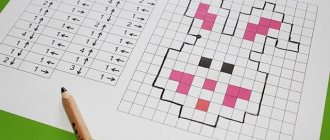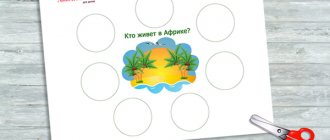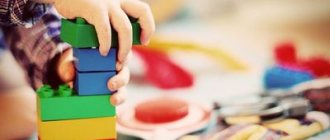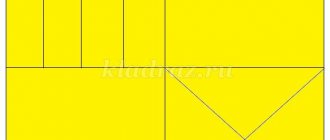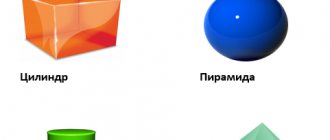We offer for you and your preschool children 5-6 years old examples for counting to 10 in colorful pictures. Such examples are interesting to solve. Simply print out the free worksheets and let your child decide. By devoting 20-30 minutes a day to counting and mathematics, 2-3 times a week, you will perfectly prepare your preschooler for school.
On our website you can download math assignments for free and print them out. Most of the tasks are decorated with colorful drawings and the child will find it interesting to study.
These materials are perfect for children to review the material they have covered during the summer holidays. Repetition of counting, logic, solving examples of addition and subtraction.
How to teach counting to 20
You can teach your child to count to 20 when he is confident in counting to 10. To quickly and easily learn to count to 20, follow these steps:
- Teach your child what zero is (if he doesn't already know) using visual examples. For example, show two books or two other identical objects and then remove them. Explain: there were two books, and now there are zero.
- Show how new numbers are formed - it will be easier for the child to understand the principle using the example of numbers ending in zero. Let's say, in the Old Russian language “dtsat” means ten and, accordingly, the number 20 is two tens (you need to count to ten twice).
- Introduce your child to the concept of “number composition” - including with the help of improvised objects: counting sticks, toys, fruits. Place 10 identical objects in a row, and on top put one object different from these ten, for example, a counting stick of a different color. Explain to your child that this is the number eleven. With sticks on top, show how you get 12, 13, 14 and other numbers up to 20.
- Instruct your child to collect a certain number of identical objects (16, 17, 18, etc.), such as small toys, and count the number of objects out loud together.
- Reinforce the material with a line of numbers from 0 to 20: this way the child will learn to count to 20 much faster. You can draw the number line yourself or use a 20cm ruler. By practicing with a ruler, the child will gradually remember how to write numbers and their correct sequence.
What else to read: Synopsis of the role-playing game “We are going to the theater” for secondary children. groups
Didactic game “Count. Counting within 10" for children 4–5 years old
Tatiana Mezentseva
Didactic game “Conte. Count within 10 “for children 4-5 years old
Annotations
In preschool age, the foundations of the knowledge a child needs in school are laid. Mathematics is a complex subject that can be challenging in school. Also, not all children have inclinations and a mathematical mindset, so when preparing for school it is important to introduce the child to the basics of counting.
Developing quantitative relationships is a complex process that causes significant difficulties for most children. Often children do not understand why they need to count, measure, and not approximately, but accurately. Without realizing the meaning of the actions they perform, preschoolers perform them mechanically, which leads to formal assimilation of knowledge.
Premature learning of counting activities inevitably leads to the fact that the idea of number and counting becomes formal. Therefore, learning to count does not begin immediately. It is preceded by preparatory work: numerous and varied exercises with a variety of objects, in which children, using appliqué and overlay techniques, compare aggregates and establish “additional” connections.”
, “less” without using numbers or counting. Taking into account all of the above, the game “Count” was created.
The game is designed for both joint and individual activities.
The games offered are designed for children aged 4 to 5 years.
Task:
Strengthening counting skills by 10.
Tasks:
1. Consolidation of reverse and ordinal counting, the ratio of number and quantity.
2. Development of attention, memory, figurative and logical thinking, the ability to analyze, compare, classify.
3. Strengthen the ability to answer questions “How much?”
, “Which number is greater?” , “Which number is lower?” , “To what extent is the number . more number? , “How much is the number .. smaller than the number?” ; strengthen the ability to combine into groups of elements for a given number, look at the total number of elements and call it a number. 4. Develop ideas about color, shape, size and properties of objects through vivid images and playful activities.
What else to read: Didactic game “Who can name the most actions?”
Material:
The game consists of ten basic cards depicting various animals from 1 to 10 and a series of numbers from 1 to 10.
Rules of the game:
Under the card, put a number corresponding to the number of objects or animals shown in the picture.
The child, having looked at the card and listened to the teacher’s task, must place a certain number.
Complication: using understanding of the meaning of the words “How many more?”
, "Least?" , “They left” , “On the right” .
How to teach counting to 10
You can teach your child to count to 10 before the age of five or, if necessary, at an older age. The main conditions for successful learning to count mentally up to 10 are a child’s good vocabulary and interest in numbers.
How to teach your child to count to 10:
- focus on numbers that you already use in everyday situations, for example: “You are four now, and soon you will be five,” “It’s time to get up, it’s already seven”;
- show pictures with different numbers of objects within 10: illustrations in books, cubes, your own drawings;
- educational videos and cartoons on relevant topics will help you quickly remember the sequence of counting to 10;
- connect the elements of mental arithmetic: teach your child to use an abacus – often children quickly learn to count to the nearest 10, manage an abacus or even a classic wooden abacus;
- use an element of the Montessori method: a famous teacher successfully taught children 3-6 years old to count, regardless of their initial skills, using the most visual practical material: money (Maria Montessori considered money exchange exercises her most effective lesson for understanding counting).
When sending your child to school, take care not only of his intellectual preparation. After all, at school the child will have to face a completely new world. Some children find it difficult to endure the adjustment period. Make sure that your child is not bullied by peers or teachers, that he does not have problems and that the “Where are my children” application will definitely help him!


